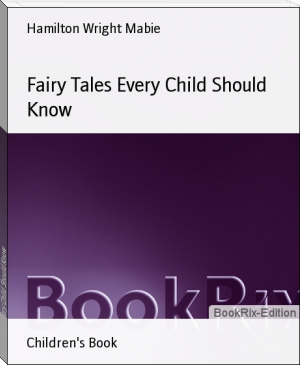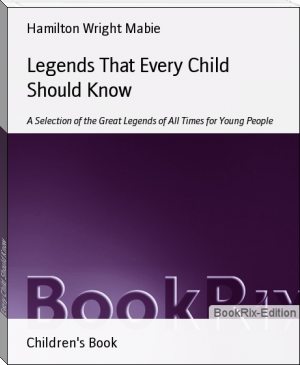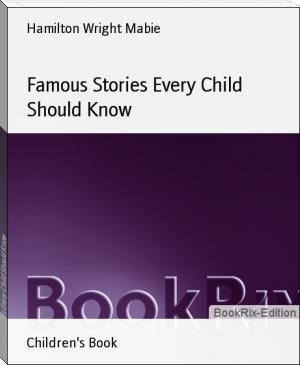Folk Tales Every Child Should Know by Hamilton Wright Mabie (e ink manga reader .TXT) 📖

- Author: Hamilton Wright Mabie
Book online «Folk Tales Every Child Should Know by Hamilton Wright Mabie (e ink manga reader .TXT) 📖». Author Hamilton Wright Mabie
CONTENTS
INTRODUCTION
CHAPTER
I. HANS IN LUCK
From Grimm's Fairy Tales.
II. WHY THE SEA IS SALT
From "Popular Tales from the
Norse," by Sir George Webbe
Dasent, D.C.L.
III. THE LAD WHO WENT TO THE NORTH WIND
From "Popular Tales from the
Norse," by Sir George Webbe
Dasent, D.C.L.
IV. THE LAD AND THE DEIL
From "Popular Tales from the
Norse," by Sir George Webbe
Dasent, D.C.L.
V. ANANZI AND THE LION
From "Popular Tales from the
Norse," by Sir George Webbe
Dasent, D.C.L.
VI. THE GRATEFUL FOXES
From "Tales of Old Japan," by
A.B. Mitford.
VII. THE BADGER'S MONEY
From "Tales of Old Japan," by
A.B. Mitford.
VIII. WHY BROTHER BEAR HAS NO TAIL
From "Nights with Uncle Remus,"
by Joel Chandler Harris.
IX. THE ORIGIN OF RUBIES
From "Folk Tales of Bengal,"
by Rev. Lal Behari Day.
X. LONG, BROAD, AND SHARPSIGHT
Translated from the Bohemian
by A.H. Wratislaw, M.A., in
"Sixty Folk Tales, from Exclusively
Slavonic Sources."
XI. INTELLIGENCE AND LUCK
Translated from the Bohemian
by A.H. Wratislaw, M.A., in
"Sixty Folk Tales, from Exclusively
Slavonic Sources."
XII. GEORGE WITH THE GOAT
Translated from the Bohemian
by A.H. Wratislaw, M.A., in
"Sixty Folk Tales, from Exclusively
Slavonic Sources."
XIII. THE WONDERFUL HAIR
Translated from the Serbian by
A.H. Wratislaw, M.A., in "Sixty
Folk Tales, from Exclusively Slavonic
Sources."
XIV. THE DRAGON AND THE PRINCE
Translated from the Serbian
by A.H. Wratislaw, M.A., in
"Sixty Folk Tales, from Exclusively
Slavonic Sources."
XV. THE GOOD CHILDREN
A Little Russian story of Galicia.
Translated by A.H.
Wratislaw, M.A., in "Sixty
Folk Tales, from Exclusively
Slavonic Sources."
XVI. THE DUN HORSE
From "Pawnee Hero Stories
and Folk Tales," by George
Bird Grinnell.
XVII. THE GREEDY YOUNGSTER
From the Norwegian tale of
Peter Christen Asbjörnsen.
XVIII. HANS, WHO MADE THE PRINCESS LAUGH
From the Norwegian tale of
Peter Christen Asbjörnsen.
XIX. THE STORY OF TOM TIT TOT
An old Suffolk Tale, given in the
dialect of East Anglia. From
"Tom Tit Tot. An Essay on
Savage Philosophy in Folk
Tale," by Edward Clodd.
XX. THE PEASANT STORY OF NAPOLEON
From "The Country Doctor,"
by Honoré de Balzac. Translated
by Katharine Prescott
Wormeley.
INTRODUCTION
When the traveller looks at Rome for the first time he does not realize that there have been several cities on the same piece of ground, and that the churches and palaces and other great buildings he sees to-day rest on an earlier and invisible city buried in dust beneath the foundations of the Rome of the Twentieth Century. In like manner, and because all visible things on the surface of the earth have grown out of older things which have ceased to be, the world of habits, the ideas, customs, fancies, and arts, in which we live is a survival of a younger world which long ago disappeared. When we speak of Friday as an unlucky day, or touch wood after saying that we have had good luck for a long time, or take the trouble to look at the new moon over the right shoulder, or avoid crossing the street while a funeral is passing, we are recalling old superstitions or beliefs, a vanished world in which our remote forefathers lived.
We do not realize how much of this vanished world still survives in our language, our talk, our books, our sculpture and pictures. The plays of Shakespeare are full of reference to the fancies and beliefs of the English people in his time or in the times not long before him. If we could understand all these references as we read, we should find ourselves in a world as different from the England of to-day as England is from Austria, and among a people whose ideas and language we should find it hard to understand.
In those early days there were no magazines or newspapers, and for the people as contrasted with the scholars there were no books. The most learned men were ignorant of things which intelligent children know to-day; only a very few men and women could read or write; and all kinds of beliefs about animals, birds, witches, fairies, giants, and the magical qualities of herbs and stones flourished like weeds in a neglected garden. There came into existence an immense mass of misinformation about all manner of things; some of it very stupid, much of it very poetic and interesting. Below the region of exact knowledge accessible to men of education, lay a region of popular fancies, ideas, proverbs, and superstitions in which the great mass of men and women lived, and which was a kind of invisible playground for children. Much of the popular belief about animals and the world was touched with imagination and was full of suggestions, illustrations, and pictorial figures which the poets were quick to use. When the king says to Cranmer in "Henry VIII:" "Come, come, my lord, you'd spare your spoons," he was thinking of the old custom of giving children at christenings silver or gilt spoons with handles shaped to represent the figures of the Apostles. Rich people gave twelve of the "apostles' spoons;" people of more moderate means gave three or four, or only one with the figure of the saint after whom the child was named. On Lord Mayor's Day in London, which came in November and is still celebrated, though shorn of much of its ancient splendour, the Lord Mayor's fool, as part of the festivities, jumped into a great bowl of custard, and this is what Ben Jonson had in mind when he wrote:
"He may, perchance, in tail of a sheriff's dinner,
Skip with a rime o' the table, from near nothing,
And take his almain leap into a custard,
Shall make my lady Maydress and her sisters,
Laugh all their hoods over their shoulders."
It was once widely believed that a stone of magical, medicinal qualities was set in the toad's head, and so Shakespeare wrote:
"Sweet are the uses of adversity;
Which, like the toad, ugly and venomous,
Wears yet a precious jewel in its head."
"A Midsummer Night's Dream" is the most wonderful fairy story in the world, but Shakespeare did not create it out of hand; he found the fairy part of it in the traditions of the country people. One of his most intelligent students says: "He founded his elfin world on the prettiest of the people's traditions, and has clothed it in the ever-living flower of his own exuberant fancy."
This immense mass of belief, superstition, fancy, is called folk-lore and is to be found in all parts of the world. These fancies or faiths or superstitions were often distorted with stories, and side by side with folk-lore grew up the folk-tales, of which there are so many that a man might spend his whole life writing them down. They were not made as modern stories are often made, by men who think out carefully what they are to say, arrange the different parts so that they go together like the parts of a house or of a machine, and write them with careful selection of words so as to make the story vivid and interesting.
The folk-tales were not written out; many of them grew out of single incidents or little inventions of fancy, and became longer and larger as they passed from one story-teller to another and were retold generation after generation.
Men love stories, and for very





Comments (0)